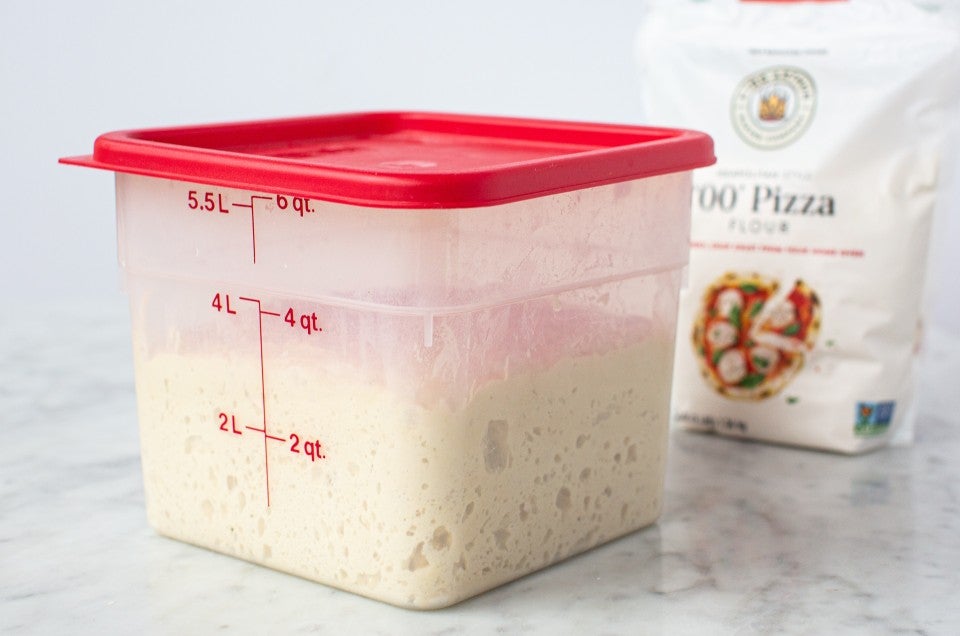


In recent weeks I’ve seen one too many bowls of rising bread dough covered with only a towel. While many of you (my mother included) rely on this as your go-to method (who can blame you, cookbooks even prescribe it), trust me that covering your dough with something better than a towel can pay big dividends for flavor and rise. Let me explain.
During the first rise in breadmaking, our goal is active fermentation. That’s why we carefully measure our yeast, pay attention to our water temperature, and even sometimes calculate desired dough temperatures. These steps support an even, healthy rate of fermentation, producing bready flavors and high-rising bakes. Good fermentation = great loaves.
Covering your dough correctly is a crucial step here. For best results, we want a non-porous, tight-fitting cover that will keep the dough from becoming too cool or developing a skin. And a towel doesn’t cut it: The porous material allows heat to escape, causing the dough to lose temperature. As the dough cools, fermentation grinds to a halt, resulting in sluggish dough with poor fermentation. (You may have read our Bread Coach piece on sluggish dough and resulting problems. Add towels to the list of things to avoid.) What’s more, the porous material that allows heat out also allows air in, drying out your dough and creating a skin that inhibits rising, shaping, and, eventually, baking. The result? Poorly fermented dough that bakes up as squat, dense bread.
To demonstrate the difference between a well-covered dough (anything that forms a non-porous, tight-fitting cover will work, such as a bowl cover or a tight-fitting lid) and a towel-covered dough, I mixed a double batch of our Classic Sandwich Bread. I placed half the dough (one loaf) into a bowl covered with a towel and the other half into a bowl with a bowl cover. I set them in the same location in my cool kitchen.
Over the course of the first rise, the dough in the towel-covered bowl dropped from 78˚F to 65˚F, while the bowl with the bowl cover on it only dropped to 74˚F. While it may seem like a small difference, that larger drop in temperature means that my towel-covered dough rises much more slowly, likely resulting in an underproofed loaf with a tight crumb and low overall volume.
Indeed, the two doughs looked like different mixes after the first rise. One was perfect — marshmallow-y and active — while the other was sluggish and dense.
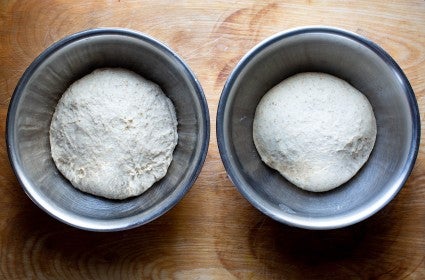
The differences didn’t end there. When I dumped the doughs out for shaping, another problem appeared: a tight skin had formed on the surface of the towel-covered dough.
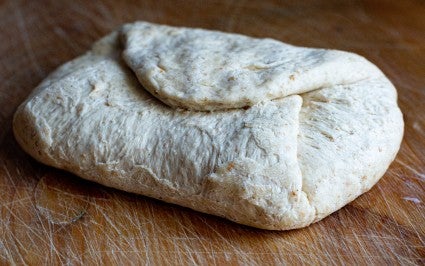
That skin proved problematic during shaping: The dry patches on the outside didn't stretch or develop tension like my well-covered, elastic dough. The leathery sections ruptured and cracked. And further, the dry skin resisted sticking to the rest of the mass, leaving me with a cracked surface and a dough prone to bursting or unraveling rather than swelling evenly during proofing and baking. In contrast, the well-covered dough was set up for success. Its moist surface adhered to itself during shaping, setting up a good final rise and a beautiful shape.
And remember how the towel-covered dough was sluggish? The volume difference is clearly apparent during shaping, with one loaf sized like a well-fed twin and the other struggling to rise.
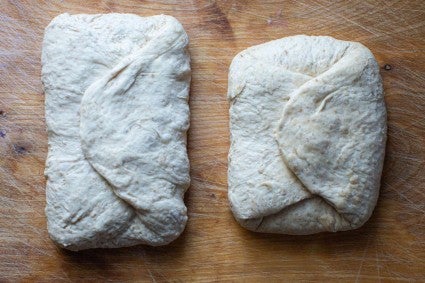
Hopeful for some improvement during the final rise, I placed the two loaves in pans and set them in a warmer spot to encourage the towel-covered loaf towards a come-from-behind victory.
I stretched a bowl cover over one and used a towel for the other. I also extended the final rise, trying to give the sluggish dough a fighting chance. But, as with the first rise, the towel-covered loaf formed yet another skin. Argh!
After the bake, the story continued with the sluggish, skinned-over loaf and our nice, open-crumbed high-riser.
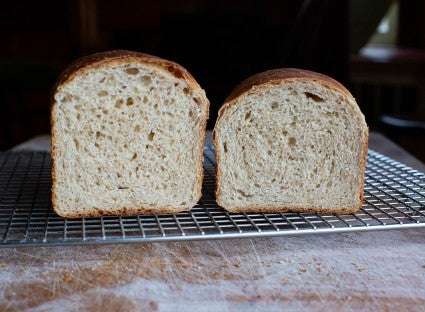
So, what can you do? Do you need to buy bowl covers? That’s certainly an option. I use them to cover my hearth-baked loaves that rise in bannetons, as well as on bowls of rising dough. I also have a few 6-quart containers that are perfect for larger batches like our Pain de Campagne.
But you don’t necessarily have to buy anything. I often just grab a large pot lid and use that over a bowl of proofing dough. A sheet tray works too — just make sure the seal is tight enough to prevent any air movement. For especially large batches I often use a food-safe trash bag, placing the entire bowl of dough inside the bag. After a few uses I use it as a trash bag so it’s not wasted.
So cover those bowls, bakers, and get ready for the high-rising, tastier days ahead!
Put your bowl-covering knowledge to use with The Easiest Loaf of Bread You'll Ever Bake:
Cover photography by Martin Philip.



April 19, 2023 at 12:38pm
So no towel for sourdough loaves either?? Thanks! I will have to try it!
April 20, 2023 at 7:24pm
In reply to So no towel for sourdough… by Stacey Geer (not verified)
Correct, Stacey, while better than nothing, we do not recommend using a towel for sourdough loaves either. Happy baking!
April 19, 2023 at 12:30pm
Thanks! I’ve been wondering about this. When using the trash bag or cover, do you do anything (spray with oil) to prevent the dough from sticking to it?
April 20, 2023 at 1:58pm
In reply to Thanks! I’ve been wondering… by Janet (not verified)
Hi Janet! A very light coating of non-stick spray or oil on the bag can be helpful as that will help prevent any sticking.
April 19, 2023 at 12:21pm
I use clear plastic hair covers I buy them in bulk from Sally's. And use until the elastic dies. I'll use greased plastic wrap for my sourdough loaves I n the final rise since those are more freeform.
April 19, 2023 at 12:21pm
Huh! I've been using a dampened dish towel for years and never had a problem with a skin forming. I wonder about the drop in temperature, though. Do you think a damp towel will also result in that temperature drop?
April 21, 2023 at 4:10pm
In reply to Huh! I've been using a… by Kevin Comeau (not verified)
Hi Kevin, because of the airflow the damp towel quickly becomes cool and the temperature of the dough will still drop.
April 19, 2023 at 12:16pm
What happens if the towel is damp or even wet (but not dripping)? That’s how I always heard the advice (a damp tea towel). I wonder if the water would just evaporate, or if the moisture in the towel would be enough to counteract some of the air exchange and heat loss.
April 20, 2023 at 7:53pm
In reply to What happens if the towel is… by Bailey (not verified)
Hi Bailey, the moisture from the towel will certainly help but we do recommend something less porous than a towel to help to prevent the dough from drying out during long proofing periods.
April 19, 2023 at 11:58am
I bought the extra large raising bucket a few years ago and love it! It does make a big difference. Great article.
Pagination